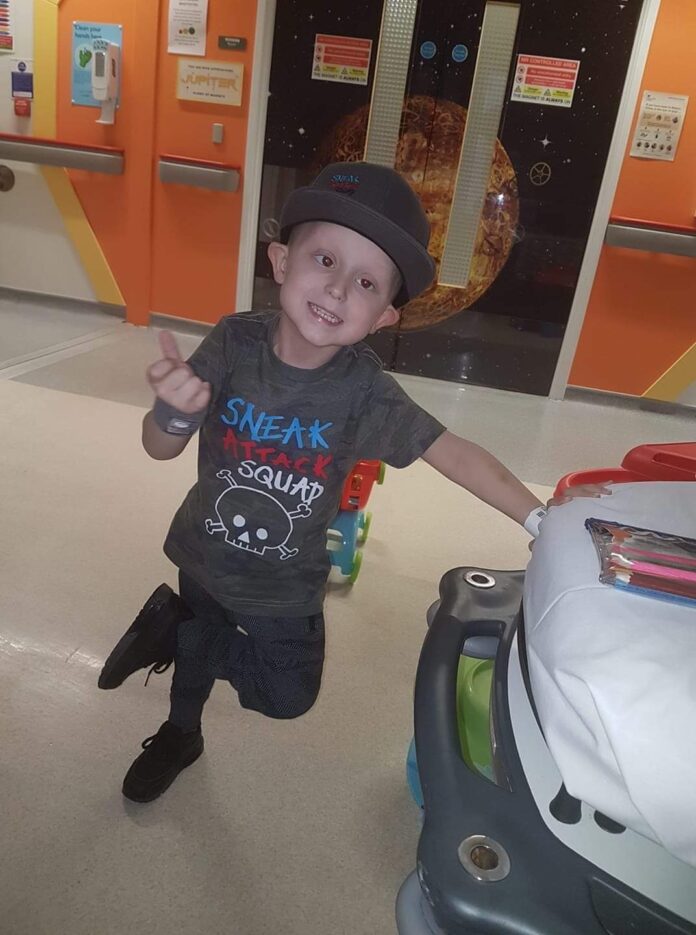A MUM from Ashton-under-Lyne – whose six-year-old son was diagnosed with a brain tumour after the school nurse spotted a squint in his eye – is backing a million-dollar research project into childhood cancer research, which is being co-led by a team of scientists from Manchester.
Carla Feno’s life was turned upside down in June last year when staff at school reported that her son Luca kept twitching his right eye. He also kept losing his balance and tripping up while out and about, as though he was “drunk”. Doctors later discovered a tumour around the size of a walnut in Luca’s brain, sitting close to his optic nerve. He was only four years old at the time.
After surgery, chemotherapy and radiotherapy, Luca’s most recent scan has shown little evidence of disease and he is now back at school and enjoying seeing his friends again. But he has been left with lasting side effects from his treatment, including memory loss and a reduced attention span which has made him more forgetful.
More than 70 per cent of children with brain tumours survive in the long term, often thanks to radiotherapy*. But although radiotherapy is one of the most effective ways to treat childhood brain cancers, it can also result in short and long-term side effects for youngsters as healthy tissue is affected by the radiation – from physical problems such as limb weakness and poor growth to developmental problems with learning and school-work.
That’s why nearly US$1million (approx £750,000) has been awarded to a transatlantic team of scientists, including researchers from The University of Manchester, The Christie NHS Foundation Trust and Royal Manchester Children’s Hospital, to research the long-term side effects of radiotherapy on children with brain tumours.
Led by University of Manchester-based child cancer specialist Dr Martin McCabe, his team will work with scientists in the US to identify the parts of children’s brains that are most sensitive to radiotherapy damage. The research project aims to create a highly detailed ‘map’ of the brain, identifying exactly which parts of healthy brain tissue should be avoided when administering radiotherapy.
The research funding from Stand Up to Cancer in the US and Cancer Research UK’s own Stand Up to Cancer initiative has also been welcomed by Carla, 40, who recalls the moments leading up to her son’s diagnosis.
She said: “Luca was constantly stumbling and staggering around, to the point where he actually looked like he was drunk. At first, I thought it might be an ear infection affecting his balance. But when his teacher also mentioned the squinting, I knew we needed to get things checked out.”
The concerned mum was advised to make an appointment with the optician, but tests showed that Luca’s eyesight appeared to be normal. Not long afterwards, the family went on their summer holiday to Spain as planned, but while they were away Luca threw up several times and was falling over even more often than usual.
The day they got back, Carla took the little boy straight to Tameside Hospital A&E as she was growing increasingly worried. It was here that doctors discovered a 3.2cm tumour – around the size of a walnut – in Luca’s brain, sitting close to his optic nerve.
Carla said: “When the doctor said it was a tumour, my world was turned completely upside down. The room literally started spinning. Deep down, a small part of me had been thinking the worst, but I can honestly say that nothing can prepare you for that kind of news. As a mother, it’s absolutely heart-breaking.”
Luca was rushed from Tameside to Royal Manchester Children’s Hospital where he had eight-hour brain surgery just a few days later to remove as much of the growth as possible. Lab analysis of the tumour tissue confirmed that Luca had a medulloblastoma – a type of children’s cancer which develops at the back of the brain.
Doctors were able to remove most of the tumour through surgery, but some was still attached to his brain stem and Carla was told that he would require a specialist form of highly-targeted radiotherapy treatment called proton beam therapy – a high energy treatment used for cancers that are close to vital or delicate parts of the body.
This treatment wasn’t available in Manchester at the time, so Carla and Luca were referred to a specialist centre in Germany for six weeks of NHS-funded radiotherapy, leaving younger brother Rocco, now 5, at home with dad Brendan. This was then followed by a nine-month course of chemotherapy in Manchester, which ended in June this year – exactly a year after Luca was first diagnosed.
Carla said: “The radiotherapy was really tough and Luca had to be sedated every day for six weeks so that he could receive the treatment. It was also hard to separate the boys for those six weeks as Rocco is non-verbal autistic and the two brothers are extremely close. We made sure we FaceTimed as often as possible so the boys could wave to each other.
“I haven’t spoken to Luca about cancer as he’s too young to understand it properly. But he knows that he needs to take medicine to get better, and that’s enough for now.
“We’ve had our challenges, but he shows amazing bravery and courage and has a huge smile on his face every day. He is my strength and inspires me to keep on going. Even when his hair fell out from the chemotherapy, he was so happy not to have to go for haircuts! I’m just so proud of him.”
Carla added: “Luca is living proof of why research into cancer is so important as, thanks to treatment, he is still here today. But although his tumour has been successfully targeted with treatment, he has sadly been left with side effects which will need monitoring for many years to come. Radiotherapy for children’s cancers is very effective, but what many people don’t realise is how harsh the treatment can be on youngsters, especially when they are blasting an area as sensitive as the brain.
“Luca’s short-term memory and attention span has definitely been affected by what he’s been through. Sometimes when we’re chatting, he’ll just zone out as though he doesn’t understand what I’m saying. And he’s also more forgetful, I can tell him something one minute that’s totally forgotten the next. As he gets older, he will need to be monitored for any more effects of the treatments.”
The Manchester-based scientists are benefitting from the new Stand Up To Cancer-Cancer Research UK Paediatric Cancer New Discoveries Challenge awards. Their work has been recognised because it reflects Stand Up To Cancer and Cancer Research UK’s shared ambition to accelerate the development of new treatments for some of the rarest and hardest to treat cancers in children and young people.
Lead scientist Dr Martin McCabe, who is based at The Christie, said: “It’s great news for Manchester that we have been awarded this funding. It’s an ambitious goal, but we hope this research could lead to safer radiotherapy treatments for childhood brain tumours – treatments that aren’t as tough on young people as the ones we use now, and maybe new treatments that could help more young people to survive this type of cancer in the future. This research could be a real game-changer for generations to come as we develop ways to deliver radiotherapy accurately to tumours but avoid sensitive areas of the brain and ultimately give patients much better lives.”
He continued: “The award is also a proud recognition of Manchester’s reputation as a world-leading centre in cancer research. Manchester remains an international leader in the fields of proton beam therapy, gene therapy and immunotherapy and is home to The Royal Manchester Children’s Hospital, the biggest children’s hospital in Europe and The Christie, the biggest single-site, dedicated cancer hospital in Europe. We’re excited to have been awarded this funding and we’re looking forward to bringing our expertise to a global team to help more young people across the world with this devastating disease.”







